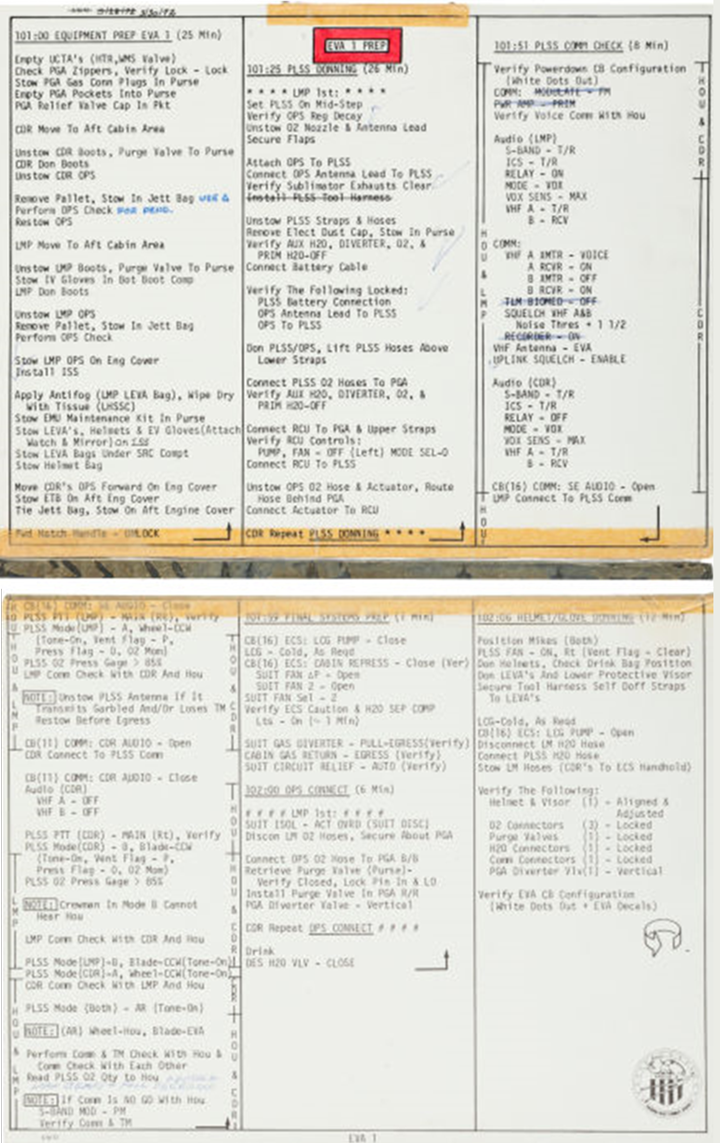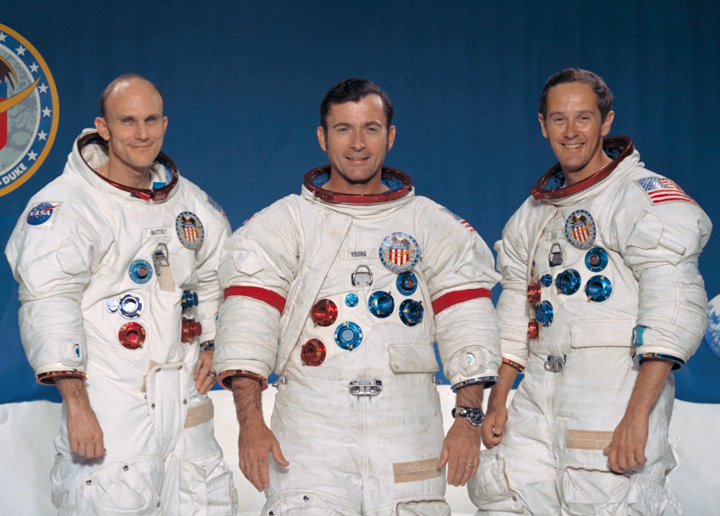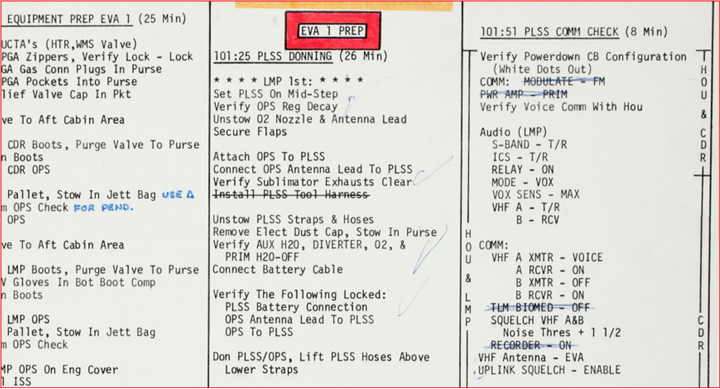Houston…We Have a Checklist
The US’ Apollo space programme was a mix of novel technologies and the mundane. Mundane to some, checklists were not new but were very essential to all those involved – both in space and to those in Mission Control Houston.
Checklists first appeared in the military in the 1930s during Boeing’s development of the (then) highly complex four engine B17 Bomber, enabling pilots to follow the steps required during the different phases of flight (pre-flight checks, take off, cruise and landing). These early checklist prototypes were developed to include various emergency situations and would prove to be so successful that aeronautical engineers could design increasingly complex aircraft without putting undue loads on the pilots operating them.
Apollo was a very complex undertaking – there could be two spacecraft both operating remotely 240,000 miles from Earth and out of communications contact with Earth for significant periods of time. The checklists and cue cards covered everything from mission rules, abort criteria, emergency procedures and activation of backup systems in the event of a total failure of a primary control system for example. These checklists and procedures got everywhere. In fact, each Moon-walking astronaut would have a book of procedures strapped to their left wrist that they could follow out on the lunar surface.
All of the Apollo crews would each log over 100 hours familiarising themselves with the numerous procedures and checklists. Apollo 11’s Command Module Pilot Michael Collins would actually call them the “fourth crew member”. These checklists were also one of the first examples of digital computers and man being able to operate together seamlessly.
Chemical engineering has embraced checklists – they are perhaps more familiar to us as operating procedures and are key to many design and operational activities that we perform day in, day out. Checklists allow the user to perform tasks in a repeatable and consistent way especially when the operators have other matters that also require their attention or where the potential hazard in omitting a key step is high, thereby ensuring that none of these steps are missed, overlooked or performed out of sequence. For example, procedures and checklists are particularly useful when isolating equipment, breaking containment, or depressurising sections of pipework or key pieces of process equipment.
Pigging activities in a chemical plant or offshore installation are just one example where checklists and procedures have a critical role to play – bridging the gap between theory and practice (eg see The Chemical Engineer issue 936 , "Degrees of Separation").
The topic of safe isolation takes us back to another example from the Apollo programme – the preparation of crew and spacecraft for a lunar surface excursion (an "EVA" in NASA speak, or extra vehicular activity). A complex activity whereby each crewman must don their spacesuit, portable life support system (PLSS) or backpack, helmet and gloves, check critical communication systems and thoroughly ensure integrity checks are correctly performed (the airless Moon is an unforgiving environment).
Once complete, final activities involve checking their PLSSs are working correctly (see "First Steps", The Chemical Engineer, 937/938) before disconnecting the primary supply hoses from the lunar module (LM) to the PLSS to become a one-man spacecraft.
The last steps involve depressurising and venting the oxygen atmosphere to the vacuum of space before stepping out onto the surface. The whole process is reversed at the end of the EVA using the flipside of the checklist.

Apollo 16
In April 1972, Apollo 16 headed for the Moon's Descartes Lunar Highlands. Having landed, astronauts John Young and Charlie Duke’s much-anticipated first excursion onto the lunar surface was going to have to wait.
It was already becoming a long day – sticking to the flight plan would have pushed them to a gruelling 29 hours. Houston’s decision to have them postpone their first EVA would extend their years of intensive preparation and training by one more sleep before they could finally step out onto the Moon’s surface.
Having powered down and configured their lunar module Orion, turning it into an exploration base for the next three days, all that remained was to close the blinds and get some much-needed sleep.
All the Apollo missions had their moments of high drama, and Apollo 16 had been no exception. At the 11th hour, just prior to commencing the descent to the lunar surface, a check of the service propulsion system (SPS) on the orbiting Command Module Casper revealed an oscillation in the engine control system. Mission rules mandated the landing be aborted and an immediate rendezvous with the command module initiated. But here lies another quiet testament to the confidence and technical capabilities the Apollo programme had acquired by the fifth lunar landing.
Extensive engineering testing and evaluation on Earth found a workaround and ultimately a green light was given – they were GO for landing. Several orbits later LM Orion made a pinpoint landing in a remarkably level area, in the words of Duke “fat on gas”, surrounded by rocks and boulders.
Pilots become explorers
All mission activities were meticulously thought out, planned and rehearsed extensively in training. None more so that the carefully-scripted four-hour procedure before their extra vehicular activity (EVA) on the lunar surface could safely begin.
The four-hour process was broken down into a sequence of smaller 20–30 minute sequences.
The EVA cue card is a carefully choreographed set of instructions, printed on non-flammable paper which had been developed and subsequently manufactured by the Scheufelen paper company in Germany. Hung up high on Orion’s main instrument panel, it was easily accessible to both crew members.

The spacesuits were the latest A7LB models, modified to allow great flexibility when sat in the LRV, fitted with additional cables to prevent the suit riding up and interfering with forward vision when seated. All up these suits would weigh a cumbersome 201 lbs on earth and so much easier to wear in the weaker lunar gravity.
The lunar explorers would not be able to use the hoses of the lunar module to supply cooling and oxygen whilst on the surface. Instead, the PLSS would turn each spacesuit into the smallest of the Apollo spacecraft – able to provide oxygen and cooling water which would prevent the astronaut from overheating, a fundamental requirement given the extremes of temperatures and the physical exertions during a seven-hour lunar EVA.
The torso of each spacesuit has a number of supply (blue) and return (red) coloured connectors with a pressure gauge mounted on the left wrist. (The red and blue colour coding also applied to the EVA gloves and wrist connectors; right was red and left blue).
The lunar EVA suits had two pairs of these blue and red air connectors and a blue cooling water port. This second pair would permit the wearer to remain connected to the lunar module life support systems whilst connecting up his PLSS hoses or vice versa at the end of an EVA.

Cue cards in practice
Despite extensive preparation and training, even these flight-certified documents would require amendment and update during the mission to reflect events of the day.
The mark-ups on the top right hand section in the photo below had been radioed up by CAPCOM (Capsule Communicator) Tony England 240,000 miles away in Houston whilst being carefully scribbled down and read back by John Young amidst the preparation activities going on in the cramped lunar module cabin. So cramped in fact, that the cue card would also identify who stood where and different points in the process and the location of critical pieces of equipment.

The first activity was locating all key equipment in the cramped LM cabin. Their suits had been taken off prior to their sleep period. The crew found to their delight that the low lunar gravity would simplify the suit-donning process; the suits standing up under their own rigidity. The bulky PLSS backpacks could be lifted one handed, a feat only Superman could have achieved back on Earth.
Finally, everything was ready for depressurisation of the LM cabin – from 5 psi to vacuum, their suits pressurised to 3.75 psi, a compromise between competing requirements of suit mobility and preventing the bends.
During the debrief back on earth, Young and Duke would reflect on their preparatory activities and specifically the cue card:
DUKE: “Those things were well organised and I thought that those set of procedures were well organised and I thought those sets of procedures for the pre and posts flowed as smooth as glass.
YOUNG: “Yes, I do, too.”
Everything had been thought about. A fourth, contingency cue card would also be packed away to cover the situation whereby a single astronaut would venture out, briefly, onto the surface.
“Egress” is a rather understated term for the final activity on the cue card that put Young and Duke into the history books as the 9th and 10th men to walk on the Moon. The culmination of years of hard work, frustration, training and anticipation was about to pay off.
EVA 1 for Apollo 16 would include a multitude of chores to deploy the lunar roving vehicle (LRV), the flag, the array of lunar surface experiments and set up the first observatory on another world. The flag came first, after which they would do the tourist thing and snap photos of each other, delighted to have reached their destination.

The Descartes Highlands had been chosen because of their assumed similarity to regions on earth that had been formed by volcanic activity; a theory that would be proven to be false.
Even as the lunar exploration team was busy conducting three EVAs on the lunar surface, the absence of any volcanic rocks was causing the geologists to revisit this lunar volcanic hypothesis.
Time out on the surface was as precious as it was finite. The crew were able to squeeze in and film a lunar grand prix, a test of the second vehicle to make it to the lunar surface. Young and Duke would even perform their own version of the lunar Olympics during the final EVA in honour of the Munich Olympics, which were also that year.
Tired, grimy and exhausted, the two lunar explorers would return to the LM to turn in for a meal and some much-needed rest. First, they had to ascend the ladder to re-enter Orion’s cramped cabin and work through the reverse side of the cue card, re-pressurising the LM and removing their bulky spacesuits. They stored their lunar samples and replenished their PLSS backpacks in readiness for EVA 2 and a trip to Stone Mountain.
In the words of Duke: “Our EVA gloves were covered with lunar dust, so as we handled the card, some of this lunar dust smeared the card”. Young would be plagued by bouts of sneezing, as the dust got everywhere.
Only then could the crew stop, report their initial observations for the science team in Houston and eat a well-deserved cold meal before reflecting on their accomplishment – an impressive 7 hours 11 minutes of productive time on the surface.
Examination of the cue card under a microscope would reveal some of the Descartes Lunar Dust, some 45 years after its safe return to earth.
After lift-off from the lunar surface and rendezvous with the command module Casper, the lunar samples, checklists and the EVA cue card were carefully transferred across as part of the mission’s flight data file. For LM Orion, its job done, its fate was to be jettisoned in lunar orbit, leaving Casper with its priceless hoard of lunar cargo to safely splash down in the Pacific Ocean three days later on 27 April, 1972.
The future
Future engineering considerations need to draw on the experiences of Apollo to inform and prevent problems on future longer-duration manned and unmanned trips to the Moon and Mars.
And for Earth-based readers of The Chemical Engineer? Well, the next time you’re following a checklist – perhaps from a seat in front of a process plant control desk – cast your mind back to the Apollo programme and consider that you’re following in the footsteps of those intrepid astronauts.
References
1. Apollo 16 The NASA Mission Reports, Volume 1 Page 195.
2. Forever Young: A Life of Adventure in Air and Space by john W Young and James Hansen, 2013.
3. https://www.hq.nasa.gov/alsj/a16/images16.html
4. https://www.nasa.gov/sites/default/files/images/624145main_1969-06-19_full.jpg
Recent Editions
Catch up on the latest news, views and jobs from The Chemical Engineer. Below are the four latest issues. View a wider selection of the archive from within the Magazine section of this site.




